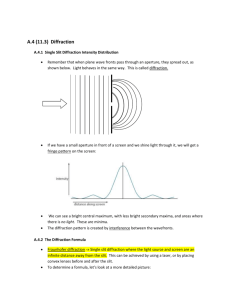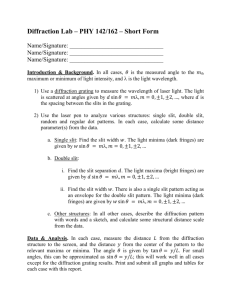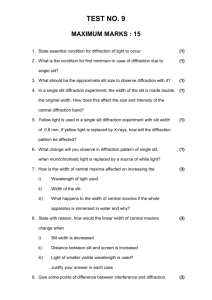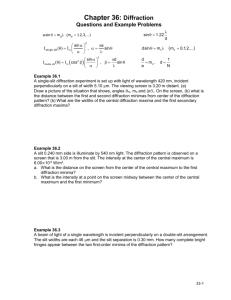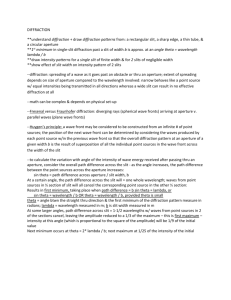3. Diffraction
advertisement
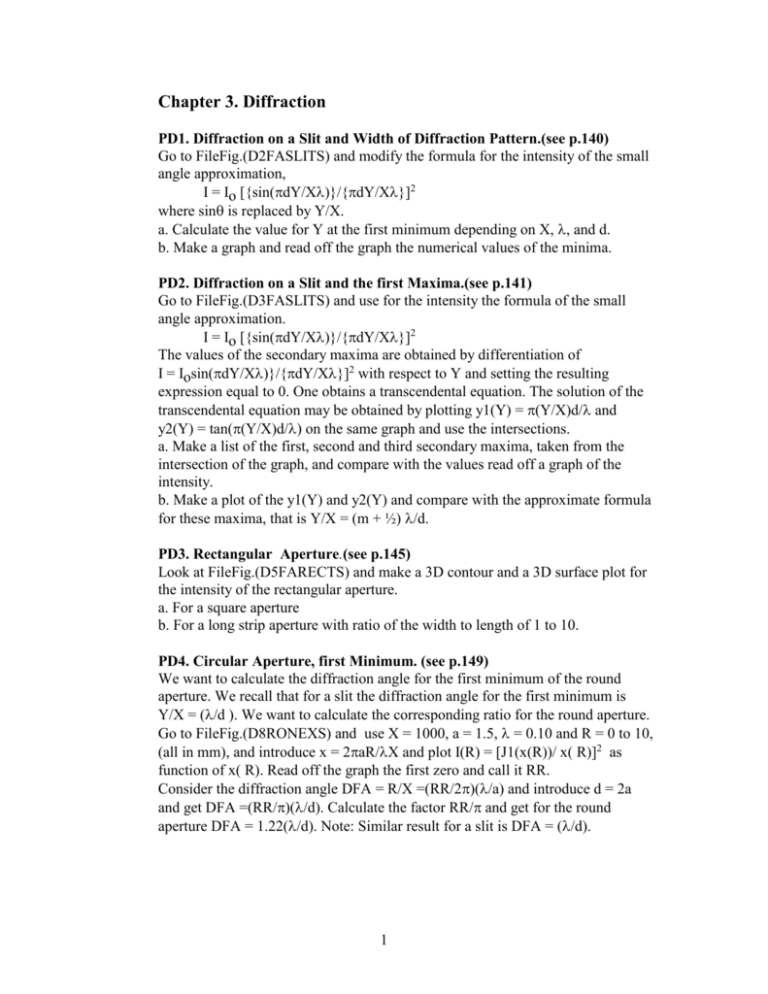
Chapter 3. Diffraction
PD1. Diffraction on a Slit and Width of Diffraction Pattern.(see p.140)
Go to FileFig.(D2FASLITS) and modify the formula for the intensity of the small
angle approximation,
I = Io [{sin(dY/X)}/{dY/X}]2
where sin is replaced by Y/X.
a. Calculate the value for Y at the first minimum depending on X, , and d.
b. Make a graph and read off the graph the numerical values of the minima.
PD2. Diffraction on a Slit and the first Maxima.(see p.141)
Go to FileFig.(D3FASLITS) and use for the intensity the formula of the small
angle approximation.
I = Io [{sin(dY/X)}/{dY/X}]2
The values of the secondary maxima are obtained by differentiation of
I = Iosin(dY/X)}/{dY/X}]2 with respect to Y and setting the resulting
expression equal to 0. One obtains a transcendental equation. The solution of the
transcendental equation may be obtained by plotting y1(Y) = (Y/X)d/ and
y2(Y) = tan((Y/X)d/) on the same graph and use the intersections.
a. Make a list of the first, second and third secondary maxima, taken from the
intersection of the graph, and compare with the values read off a graph of the
intensity.
b. Make a plot of the y1(Y) and y2(Y) and compare with the approximate formula
for these maxima, that is Y/X = (m + ½) /d.
PD3. Rectangular Aperture.(see p.145)
Look at FileFig.(D5FARECTS) and make a 3D contour and a 3D surface plot for
the intensity of the rectangular aperture.
a. For a square aperture
b. For a long strip aperture with ratio of the width to length of 1 to 10.
PD4. Circular Aperture, first Minimum. (see p.149)
We want to calculate the diffraction angle for the first minimum of the round
aperture. We recall that for a slit the diffraction angle for the first minimum is
Y/X = (/d ). We want to calculate the corresponding ratio for the round aperture.
Go to FileFig.(D8RONEXS) and use X = 1000, a = 1.5, = 0.10 and R = 0 to 10,
(all in mm), and introduce x = 2aR/X and plot I(R) = [J1(x(R))/ x( R)]2 as
function of x( R). Read off the graph the first zero and call it RR.
Consider the diffraction angle DFA = R/X =(RR/2)(/a) and introduce d = 2a
and get DFA =(RR/)(/d). Calculate the factor RR/ and get for the round
aperture DFA = 1.22(/d). Note: Similar result for a slit is DFA = (/d).
1
PD5. Circular Aperture, Comparison with Slit.(see p.149)
Go to FileFig.(D8RONEXS) and modify the graph for a comparison of the
diffraction pattern of a slit with the diffraction pattern of a round aperture. Use X
= 1000, a = 1, = 0.002 and R = 0 to10. For the slit we have 2a = d and have to
replace the Bessel function by the sine function, call it I1(R). When plotted on the
same graph, we find that I1( R) is normalized to 1 at R = 0, while I(R ) is not.
Find the value of I( R) at R = 0 and multiply the Bessel function accordingly.
Compare the values of the first minima, which are 1 and 1.22 because and “a”
have been chosen accordingly. Observe that the overall width of the diffraction
pattern of the circular aperture is larger than the one for the slit. Note that the plot
for the slit is a linear plot, while the plot for the round aperture is a radial plot.
PD6. Double Slit.(see p.153)
Assume that the slit openings are ½ of the periodicity constant “a”. Look at
FileFig.(D9FAGRAMPS) and reduce the formula of the interference factor to the
one for a double slit. Use the formula sin 2 = 2 sin cos.
a. Modify the file for the small angle approximation and use (all in mm) d = 0.1,
= 0.0005, a = 0.5, Y = -50 to 50 and X = 4000 and N = 5.
b. Change d from 0.1 to 0.5 and correlate the ratio a/d to the suppressed orders of
diffraction.
PD7. Grating at Normal Incidence.(see p.153)
Look at FileFig.(D9FAGRAMPS) and write the formula in small angle
approximation. Use (all in mm) d =.1, = .0005, a = .34, Y = 0 to 8 and X =
4000.
a. There are N - 2 side maxima and N -1 side minima.
i). Consider N = 6 and count the distances between the side minima.
ii). Are the side maxima exactly between the side minima?
b. Take d = 0.1 and enlarge “a” from 0.1 to 0.2 and so on. How does the
suppression of orders depend on the ratio of a/d?
c. Derive the elementary grating formula (a sin()) = m
d. Change the wavelength to twice its value and to one half and explain what
happens to the pattern.
PD8. Amplitude Grating.(see p.156)
Go to FileFig.(D11FAGRANGS) and use (all in mm) d = 0.001, = 0.0005, a =
0.002, N = 6, and from -0.5 to 0.5 and set = -0.001. Call these formulas I1,
D1, P1 and write a second set, I2, D2, and P2 and replace in it sin + sin by
sin( + ). Plot set 1 in red and set 2 in blue for = -0.001.
Start comparing set 1 for = -.001 with set 2 for = -.001 and change both angles
by the same value until a notable change can be seen. Note the asymmetry with
respect to = 0
2
PD9. Echelette Grating.(see p.158)
Look at FileFig.(D12FAELGRS) and modify for three plots depending on the
angle in degrees for 1, 2, 3. Use = -54.01, -53.99 to 54, d = 37, a = 40, = 10
(all in microns) and substitute for ( + ) in the diffraction factor (2/360)( +),
and in the interference factor (2/360)( ).
a. Set 1 = 0 and determine 2 and 3 such that the maximum intensity is at the
positive first order and negative second order, respectively.
b. Modify the file for three graphs with the same , but for three wavelengths. Use
as a start for all 10 microns and = 14.5, choose the value to have the maximum
at the first positive interference order. Use for the plot of P1 to P3 a bold solid line
and change 2 and 3 such that the corresponding intensities are about equal, and
2 times 2 is just less than 3. Note: The range from 2 to 3 covers just a little
bit less that one octave and can be used for spectroscopy without disturbance of
higher order light.
PD10.Resolution depending on N and d/a ratio .(see p.162)
Go to FileFig.(D13FAGRRES) and do the third application of FileFig.3.13 on
page 162. We want to changes the ratio of grating opening d to periodicity
constant a and see how it effects the resolution.
a. Consider a pair of chosen wavelengths resolved in fourth order. Change d/a
from 0.05, 0.06 to.1, what happens with the resolution?
b. Change d/a such that the fourth, third and second order can not be used.
c. What happens to the grating when d/a = 1 and the first order disappears?
PD11. Grating Resolution.(see p.163)
Determination of “Rayleigh distance”. Go to FileFig.(D14FAGRRES3DS) and
use X = 4000mm, = 0.0005mm, R = 0,0.1 to 50 and set a = .08. Look at the
graph with the Bessel function and change b such that the maximum of the second
is at the first minimum of the first. Check the 3D graph for the determined b.
PD12. Babinet’s Principle.(see p.166)
Go to FileFig.(D15FABAGRS) and use = -0.2001, -0.1999 to 2, a = 0.006mm,
= 0.0005mm, N = 6, and d1 = a – d2. Change d2 from 0.0035 to 0.0045. While
the intensity of each pattern is changing, the pattern is the same. However,
changing “a” changes the pattern.
PD13. Fresnel and Far Field Diffraction of a Slit and round Aperture.(see
p.173)
Go to FileFig.(D19FESLITS) and plot the Fresnel diffraction of a single slit. Use
Y = -10,-9.9 to 10, X = 4000mm, = .0005mm and d =2.01mm.(Make Tol =.1)
a. Fresnel diffraction of slit: Call the intensity I1(Y) and normalize. Call the
variable Z and determine I1(Z) for Z = 0.0001. Divide I1(Y) by I1(Z) and get for
Y = 0 the value of I1(0) =1.
3
b. Far Field diffraction of slit: Go to FileFig.(D2FASLITS) and change to the
small angle approximation. Use the same parameter and call the intensity I2(Y)
and plot it on the same graph with I1(Y).
c. Far field diffraction of Round aperture. Go to FileFig.(D6FARONS). Use the
same parameter, a = d/2 and call R now Y and the intensity I3(Y). Normalize the
intensity and plot I3(y) on the same graph with I1(Y) and I2(Y). Give an
interpretation of the graphs with respect to position of side minima and maxima
and their intensities.
PD14. Fresnel Diffraction on an Edge.(see p.175)
Go to FileFig.(D20FEEDGES) and look at the first graph for the edge. There
Cp(Y) and Sp(Y) have been set for an infinite large slit. The second graph is for a
finite slit. Observe that one gets the diffraction pattern of a small slit when using
p(Y) = (Y – b) with b = 1. When going to larger values of b one observes the
pattern of a larger and larger slit. Making b too large, takes too much time for the
calculation and one has to go to the approach used for the first graph.
4

